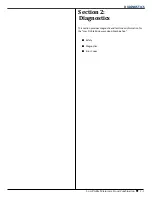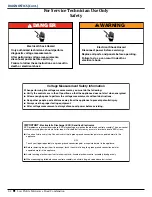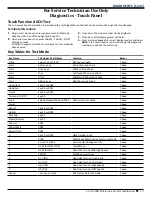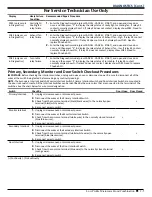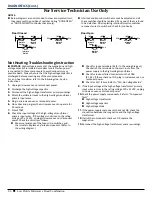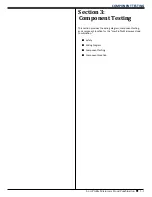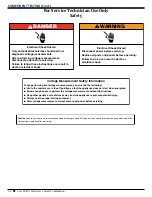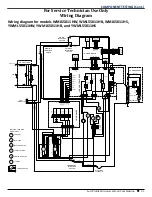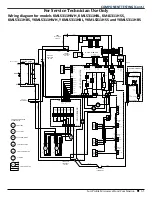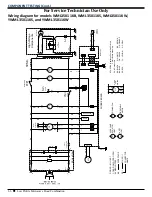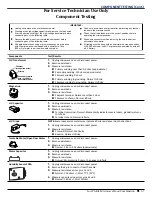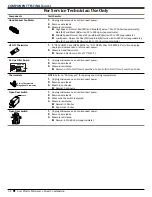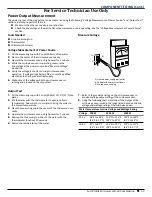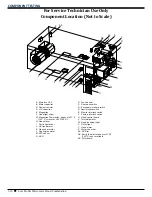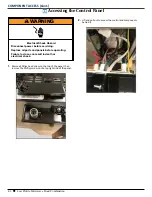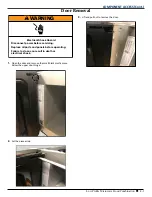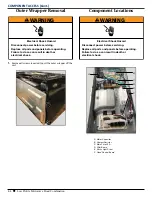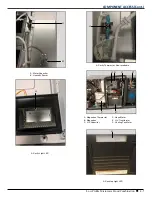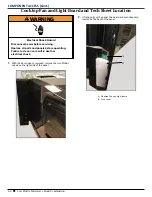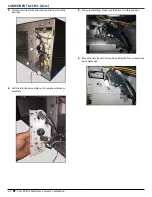
For Service Technician Use Only
COMPONENT TESTING (Cont.)
Low Profile Microwave Hood Combination
n
3-7
Component Testing
Components
Test/Results
H.V. Transformer
1.
Unplug microwave oven or disconnect power.
2.
Remove wire leads.
3.
Measure resistance:
n
Primary winding: Less than 0.5 ohm (approximate)
n
Secondary winding: 120 ohms (approximate)
n
Filament winding: 0 ohms
n
Primary winding to grounding: Normal: Infinite
n
Filament winding to grounding: Normal: Infinite
Magnetron
1.
Unplug microwave oven or disconnect power.
2.
Remove wire leads.
3.
Measure resistance:
n
Filament terminal: Normal: Less than 1 ohm
n
Filament to chassis: Normal: Infinite
H.V. Capacitor
1.
Unplug microwave oven or disconnect power.
2.
Remove wire leads.
3.
Measure resistance:
n
Terminal to terminal: Normal: Momentarily indicates several ohms, gradually returns
to Infinite
n
Terminal to case: Normal: Infinite
H.V. Diode
NOTE:
Some inexpensive meters may indicate infinite resistance in both directions.
1.
Unplug microwave oven or disconnect power.
2.
Measure resistance:
n
Forward: Normal: Continuity
n
Reverse: Normal: Infinite
Turntable Motor/Open Door Motor
1.
Unplug microwave oven or disconnect power.
2.
Remove wire leads.
3.
Measure resistance:
n
Normal: 2.4k to 3.2k ohms (approximate)
Motor Capacitor
1.
Unplug microwave oven or disconnect power.
2.
Remove wire leads.
3.
Measure resistance:
n
Normal: Momentarily 0 ohms, then goes to Infinite
Humidity Sensor PCBA
1.
Unplug microwave oven or disconnect power.
2.
Remove the 4-pin connector from the cable.
3.
Measure resistance across pins 1 and 2.
n
Normal: 10K ohms +/-5% at 77°F (25°C)
4.
Measure capacity value across pins 3 and 4.
n
Normal: 180 pF +/-5% at 55%RH
IMPOR
TANT:
Unplug microwave oven or disconnect power.
Discharge the high-voltage capacitor and remove the lead wires
from the primary winding of the high-voltage transformer before
conducting any of the following tests.
Remove the lead wires from the related component before
conducting any of the following tests.
All operational checks using microwave energy must be done
with the microwave oven loaded with a minimum of 8 oz
(250 mL) of water in a microwave-safe container.
Conduct a microwave energy test after performing any tests or
repairs to the microwave oven.
Check that all wire leads are in the correct positions before
operating the microwave oven.
Grasp wire connectors when removing the wire leads from
microwave oven parts.
All testing must be done with an ohmmeter having a sensitivity
of 20,000 ohms per volt DC or greater and powered by at least
a 9 V battery.
Primary
Filament
(orange/red wires)
Secondary (white
wire - ground to
transformer case)
1
2
3
4

